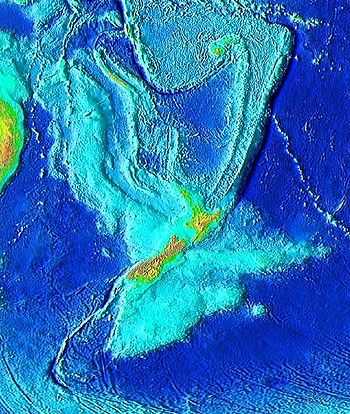Lord Howe Rise

The Lord Howe Rise is a deep sea plateau which extends from south west of New Caledonia to the Challenger Plateau, west of New Zealand in the south west of the Pacific Ocean. To its west is the Tasman Basin and to the east is the New Caledonia Basin.[1] Lord Howe Rise has a total area of about 1,500,000 square km,[1] and generally lies about 750 to 1,200 metres under water.[2] It is part of Zealandia, a much larger continent that is now mostly submerged, and so is composed of continental crust.
Formation
The Lord Howe Rise was formed by Seafloor spreading which also resulted in the creation of the Tasman Sea.[3] It was rifted away from Eastern Australia by a mid-ocean ridge that was active from 80 to 60 million years ago, and now lies 800 kilometres offshore from mainland Australia.
The Lord Howe Rise contains a line of seamounts called the Lord Howe seamount chain which formed during the Miocene period when this part of Zealandia existed over the Lord Howe hotspot. Lord Howe was the last volcano to erupt on the rise.[3]
Islands, reefs and seamounts
Lord Howe Island and Ball's Pyramid cap a seamount towards the central east of the rise in an area known as the Lord Howe platform. The Lord Howe seamount chain is extends northwards along the rise. The seamounts provide habitat to a diverse range of marine species which attracts commercial fishers.
Further north is the Elizabeth and Middleton part of the Coral Sea Islands, considered to be the most southern platform reefs on Earth.
Environment
The Seabed on the rise is mostly sandy mud with some volcanic outcrops, gravel and boulders.[2]
The Coris bulbifrons is endemic to reefs only on the Lord Howe Rise and the West Norfolk Rise.[4]
Resources
Much of the basin remains unexplored in relation to oil and gas reserves.[5]
See also
References
- ↑ 1.0 1.1 "Lord Howe Rise". Regional petroleum geology of Australia. Geoscience Australia. 16 June 2003. Retrieved 2007-04-19.
- ↑ 2.0 2.1 Harris, Peter T.; Scott L. Nichol; Tara J. Anderson; Andrew D. Heap (2011). "57: Habitats and Benthos of a Deep Sea Marginal Plateau, Australia". Seafloor Geomorphology As Benthic Habitat: GeoHAB Atlas of Seafloor Geomorphic Features and Benthic Habitats. Elsevier. p. 777. ISBN 0123851408. Retrieved 26 June 2013.
- ↑ 3.0 3.1 Mueller-Dombois, Dieter (1998). Vegetation of the Tropical Pacific Islands. Springer. p. 167. ISBN 0387983139. Retrieved 26 June 2013.
- ↑ Gibson, Robin N.; R. J. A. Atkinson; J. D. M. Gordon (2011). Oceanography and Marine Biology, Volume 49. CRC Press. p. 216. ISBN 1439853649. Retrieved 26 June 2013.
- ↑ Misha Schubert and Barry Fitzgerald (2009-04-22). "National bonanza sitting on shelf". The Age. Fairfax Digital. Retrieved 2009-12-04.